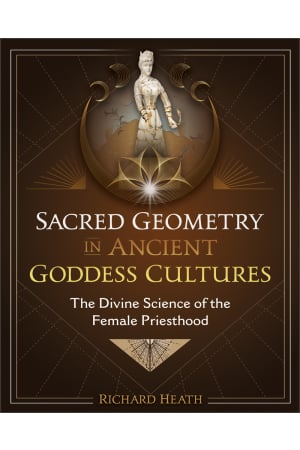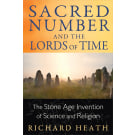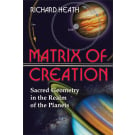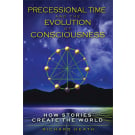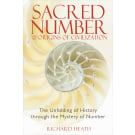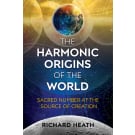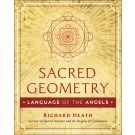Sacred Geometry in Ancient Goddess Cultures
The Divine Science of the Female Priesthood
By (Author) Richard Heath
Availability:
In Stock
- Pages: 256
- Book Size: 8 x 10
- ISBN-13: 9781644116555
- Imprint: Inner Traditions
- On Sale Date: March 26, 2024
- Format: Hardcover Book
- Illustrations: Full-color throughout
Examines the ancient cosmic science of the female megalithic astronomers
Long before Pythagoras and Plato, there existed matrilineal societies around the Mediterranean, led by women with a sophisticated understanding of astronomy and sacred science. In this detailed exploration, Richard Heath decodes the cosmological secrets hidden by ancient goddess-centered cultures on the islands of Malta and Crete and at Gobekli Tepe in Turkey.
Long before Pythagoras and Plato, there existed matrilineal societies around the Mediterranean, led by women with a sophisticated understanding of astronomy and sacred science. In this detailed exploration, Richard Heath decodes the cosmological secrets hidden by ancient goddess-centered cultures on the islands of Malta and Crete and at Gobekli Tepe in Turkey.
• Describes the shared sacred geometry and astronomy knowledge in the megalithic monuments, temples, and secret calendars of the matrilineal cultures of Malta, Gobekli Tepe, and the Minoans of Crete
• Shows how early Christians helped preserve ancient science by encoding it in the rock-cut churches of the Cappadocia region of Turkey
• Explains how Greek myths reveal the transition from matriarchy to patriarchy
Long before Pythagoras and Plato, before arithmetic and Christianity, there existed matrilineal societies around the Mediterranean, led by women with a sophisticated understanding of astronomy and sacred science. In this detailed exploration, Richard Heath decodes the cosmological secrets hidden by ancient goddess-centered cultures on the island of Malta, at Göbekli Tepe in Turkey, and on the Greek island of Crete.
Heath reveals how the female astronomers of Malta built megaliths to study the sun, moon, and planets, counting time as lengths and comparing lengths using geometry. He shows how they encoded their cosmological and astronomical discoveries, their “astronomy of the goddesses,” in the geometries of their temples and monuments. Examining Maltese and Cretan artifacts, including secret calendars, he details how the Minoans of Crete transformed Maltese astronomy into a matriarchal religion based on a Saturnian calendar of 364 days. He also reveals evidence of the precursors of Maltese astronomical knowledge in the monuments of Göbekli Tepe.
Looking at the shift from sacred geometry to arithmetic in ancient Mediterranean cultures, the author parallels this change in mindset with the transition from matriarchal to patriarchal cultures. He reveals how Greek myths present a way to see the matriarchal past through patriarchal eyes, detailing how Saturn’s replacement by Jupiter-Zeus symbolizes the transition from matriarchy to patriarchy. The author examines how the early Christians helped preserve the ancient astronomy of the goddesses, due to its connections to Christ’s cosmological teachings, by encoding this astronomy in the artwork of the rock-cut churches and monasteries of the Cappadocia region of Turkey.
Revealing how our planet—with its specific harmonics and geometries within our star system—is uniquely designed to support intelligent life, the author shows how this divine spiritual truth was known to the ancient astronomers.
• Shows how early Christians helped preserve ancient science by encoding it in the rock-cut churches of the Cappadocia region of Turkey
• Explains how Greek myths reveal the transition from matriarchy to patriarchy
Long before Pythagoras and Plato, before arithmetic and Christianity, there existed matrilineal societies around the Mediterranean, led by women with a sophisticated understanding of astronomy and sacred science. In this detailed exploration, Richard Heath decodes the cosmological secrets hidden by ancient goddess-centered cultures on the island of Malta, at Göbekli Tepe in Turkey, and on the Greek island of Crete.
Heath reveals how the female astronomers of Malta built megaliths to study the sun, moon, and planets, counting time as lengths and comparing lengths using geometry. He shows how they encoded their cosmological and astronomical discoveries, their “astronomy of the goddesses,” in the geometries of their temples and monuments. Examining Maltese and Cretan artifacts, including secret calendars, he details how the Minoans of Crete transformed Maltese astronomy into a matriarchal religion based on a Saturnian calendar of 364 days. He also reveals evidence of the precursors of Maltese astronomical knowledge in the monuments of Göbekli Tepe.
Looking at the shift from sacred geometry to arithmetic in ancient Mediterranean cultures, the author parallels this change in mindset with the transition from matriarchal to patriarchal cultures. He reveals how Greek myths present a way to see the matriarchal past through patriarchal eyes, detailing how Saturn’s replacement by Jupiter-Zeus symbolizes the transition from matriarchy to patriarchy. The author examines how the early Christians helped preserve the ancient astronomy of the goddesses, due to its connections to Christ’s cosmological teachings, by encoding this astronomy in the artwork of the rock-cut churches and monasteries of the Cappadocia region of Turkey.
Revealing how our planet—with its specific harmonics and geometries within our star system—is uniquely designed to support intelligent life, the author shows how this divine spiritual truth was known to the ancient astronomers.
Preface
PART ONE
Megaliths Built by the Goddess
Introduction to Part One
The Atlantic Megalithic
The Mediterranean Megalithic
1 The Language of the Mesolithic
The Northern and Southern Branches of Megalithism
Stepping-Stones to Numeracy
The Geometrical Origins of the Measures
The Numerical Nature of Mesolithic Astronomy
Resequencing Prehistory
2 The Mediterranean Tradition
Initial Analysis of Göbekli Tepe
A Matriarchal Megalithic
The Sleeping Goddess of Malta
Stellar Astronomy at Malta
Interpreting Göbekli Tepe
3 Reunion of the Megalithic Latitudes
The Bluestone Culture
The Significance of Latitude for the Megalithic
A Pyramidion for the Great Pyramid
Britain’s Circular Geodetic Monument
The Stonehenge Trilithons as Synods of Venus
PART TWO
The Mediterranean Transmission
Introduction to Part Two
4 Time, Gender, and Human History
Gender Selection within Prehistory
Gender Transformational Themes
Origins of The Mysteries
5 Matriarchal Crete in the Bronze Age
The Monolith Basement at Knossos
The Kernos of Malia Palace
The Horns of Consecration as Alignments
The Oval House
Why Matriarchal Astronomy Happened
The Significance of Form to Megalithic Astronomy
The Iconography of the Double Axe
6 Pythagoras, the Bible, and Plato
Numbers as Multidimensional Symbols, Rather Than Lengths
Pythagoras
The Parthenon
Plato’s Dialogues
The Bible as a Neolithic Tale
PART THREE
The Role of Providential History
Introduction to Part Three
7 Cappadocian Crossroads in Anatolia
Early Christianity and the Four Gospels
The Cappadocian Creed
Secrets within Orthodox Churches
Interpretation of Ayvali Kelise
Interpretation of Haçlı Kelise
Evolution of Orthodox Churches in Cappadocia
Orthodox Transmission of the Perimeter and Area Models
The Cappadocian Cross
8 The Arctic Origins of Astronomical Symbolism
The Phenomenology of Indra
The Arctic Framework and Its Motion
9 The Vedas in Southeast Asia
Angkor Wat
Water, Time, and Irrigation
The Middle Enclosure
The Inner Temple and Enclosure
10 Rome: The Goddess within the Vatican
Rebuilding Saint Peter’s Basilica
Extending the Design
The Vinca and da Vinci
11 Design for a Living Planet
The Chaldean Model
The Moon as Football for the Gods
Integrating Gravity Using Square Areas
The Grand Design
POSTSCRIPT
The Deep Significance of Our Past
APPENDIX
Astronomical Periods and Their Durations
Notes
Bibliography
Index
PART ONE
Megaliths Built by the Goddess
Introduction to Part One
The Atlantic Megalithic
The Mediterranean Megalithic
1 The Language of the Mesolithic
The Northern and Southern Branches of Megalithism
Stepping-Stones to Numeracy
The Geometrical Origins of the Measures
The Numerical Nature of Mesolithic Astronomy
Resequencing Prehistory
2 The Mediterranean Tradition
Initial Analysis of Göbekli Tepe
A Matriarchal Megalithic
The Sleeping Goddess of Malta
Stellar Astronomy at Malta
Interpreting Göbekli Tepe
3 Reunion of the Megalithic Latitudes
The Bluestone Culture
The Significance of Latitude for the Megalithic
A Pyramidion for the Great Pyramid
Britain’s Circular Geodetic Monument
The Stonehenge Trilithons as Synods of Venus
PART TWO
The Mediterranean Transmission
Introduction to Part Two
4 Time, Gender, and Human History
Gender Selection within Prehistory
Gender Transformational Themes
Origins of The Mysteries
5 Matriarchal Crete in the Bronze Age
The Monolith Basement at Knossos
The Kernos of Malia Palace
The Horns of Consecration as Alignments
The Oval House
Why Matriarchal Astronomy Happened
The Significance of Form to Megalithic Astronomy
The Iconography of the Double Axe
6 Pythagoras, the Bible, and Plato
Numbers as Multidimensional Symbols, Rather Than Lengths
Pythagoras
The Parthenon
Plato’s Dialogues
The Bible as a Neolithic Tale
PART THREE
The Role of Providential History
Introduction to Part Three
7 Cappadocian Crossroads in Anatolia
Early Christianity and the Four Gospels
The Cappadocian Creed
Secrets within Orthodox Churches
Interpretation of Ayvali Kelise
Interpretation of Haçlı Kelise
Evolution of Orthodox Churches in Cappadocia
Orthodox Transmission of the Perimeter and Area Models
The Cappadocian Cross
8 The Arctic Origins of Astronomical Symbolism
The Phenomenology of Indra
The Arctic Framework and Its Motion
9 The Vedas in Southeast Asia
Angkor Wat
Water, Time, and Irrigation
The Middle Enclosure
The Inner Temple and Enclosure
10 Rome: The Goddess within the Vatican
Rebuilding Saint Peter’s Basilica
Extending the Design
The Vinca and da Vinci
11 Design for a Living Planet
The Chaldean Model
The Moon as Football for the Gods
Integrating Gravity Using Square Areas
The Grand Design
POSTSCRIPT
The Deep Significance of Our Past
APPENDIX
Astronomical Periods and Their Durations
Notes
Bibliography
Index
Richard Heath, M.Sc., is a system designer who studies the technical achievements of the ancient world, from those of the megalithic astronomers to sacred building design. He is the author of six books, including Sacred Number and the Origins of Civilization and Sacred Geometry: Language of the Angels. He lives near Cardigan in Wales.
“Richard Heath’s fascinating and highly readable book presents a decoding of the metrology of Göbekli Tepe of 10,000 BCE and advances arguments that support its role as a place for the worship of the Goddess. Although the megaliths of Europe were to come nearly 5,000 years later, the book marshals evidence from mathematics, astronomy, sacred architecture, and tone theory to show that these structures were a successor to Göbekli Tepe. The book disentangles many threads that went into the creation of the Classical Age.” Subhash Kak, Regents Professor at Oklahoma State University
and author of The Astronomical Code of the R. gveda
“Richard Heath’s in-depth study of the sacred science and cosmology of the ancient matrilineal societies around the Mediterranean is a compelling tour de force. Beautifully explained with clear diagrams and tables, the implications of this work are far reaching.” Allan Brown, coauthor of Crooked Soley: A Crop Circle Revelation
“In this extraordinary book, Richard Heath synthesizes more than 10,000 years of art, architecture, harmony, geometry, astronomy, and metrology, once again demonstrating the reach, power, and persistence of these perennial traditions.” John Martineau, CEO of Wooden Books
“The esoteric knowledge encoded in ancient sacred sites is being revealed now. As the result of more than two hundred years of global archaeology and site analysis using metrology, sacred geometry, and cosmological analysis, surprising insights about sacred places are coming forth. These remarkable findings are brilliantly described in Richard Heath’s Sacred Geometry in Ancient Goddess Cultures. He shows us how Mesolithic priestesses and Neolithic priests designed sacred places to resonate with the powers of Earth in synchronicity with the cycles of the moon, planets, and stars. Then later cultures, such as the Greeks, followed ancient guidance as well as using music, harmony, mythology, and storytelling. As I contemplated these insights pouring out of Heath’s marvelously insightful mind, I felt a bond with these creators; I could feel their joy! This wonderful and beautifully illustrated book invites us to feel Gaia, the sacred feminine of Earth. For me, this ancient lineage can be described as the Matriarchy through Patriarchy into Humanarchy—our return to ecological worship—knowing Earth in our bodies as we contemplate the cosmos.” Barbara Hand Clow, author of Awakening the Planetary Mind
“I have been reading and learning from Richard Heath’s books over the last 20 years; Sacred Geometry in Ancient Goddess Cultures is the best he has written, compiling the knowledge and experience gained in previous books into a single masterpiece.” Noor Bosra, author of Plato and the Quran
“Sacred numbers have always been a part of Richard Heath’s writing, and it is no surprise that in this book he makes the case that religion developed from a pure science of horizon astronomy. This ancient knowledge evolved over thousands of years and influenced religion as practiced today. The author describes three major themes: that horizon astronomy developed in matriarchal societies thousands of years ago; that this knowledge was subsumed by a transition to a patriarchal system; and that in this transition, numbers—having lost their true meaning—became sacred. You may be left pondering what if the transition from Goddess to Father had not taken place.” Dan Palmateer, ancient geometry researcher
“A valuable body of research in which Heath weaves a fine web of intrigue and illumination.” Mark Vidler, coauthor of Sacred Geometry of the Earth
“Richard Heath’s in-depth study of the sacred science and cosmology of the ancient matrilineal societies around the Mediterranean is a compelling tour de force. Beautifully explained with clear diagrams and tables, the implications of this work are far reaching.” Allan Brown, coauthor of Crooked Soley: A Crop Circle Revelation
“In this extraordinary book, Richard Heath synthesizes more than 10,000 years of art, architecture, harmony, geometry, astronomy, and metrology, once again demonstrating the reach, power, and persistence of these perennial traditions.” John Martineau, CEO of Wooden Books
“The esoteric knowledge encoded in ancient sacred sites is being revealed now. As the result of more than two hundred years of global archaeology and site analysis using metrology, sacred geometry, and cosmological analysis, surprising insights about sacred places are coming forth. These remarkable findings are brilliantly described in Richard Heath’s Sacred Geometry in Ancient Goddess Cultures. He shows us how Mesolithic priestesses and Neolithic priests designed sacred places to resonate with the powers of Earth in synchronicity with the cycles of the moon, planets, and stars. Then later cultures, such as the Greeks, followed ancient guidance as well as using music, harmony, mythology, and storytelling. As I contemplated these insights pouring out of Heath’s marvelously insightful mind, I felt a bond with these creators; I could feel their joy! This wonderful and beautifully illustrated book invites us to feel Gaia, the sacred feminine of Earth. For me, this ancient lineage can be described as the Matriarchy through Patriarchy into Humanarchy—our return to ecological worship—knowing Earth in our bodies as we contemplate the cosmos.” Barbara Hand Clow, author of Awakening the Planetary Mind
“I have been reading and learning from Richard Heath’s books over the last 20 years; Sacred Geometry in Ancient Goddess Cultures is the best he has written, compiling the knowledge and experience gained in previous books into a single masterpiece.” Noor Bosra, author of Plato and the Quran
“Sacred numbers have always been a part of Richard Heath’s writing, and it is no surprise that in this book he makes the case that religion developed from a pure science of horizon astronomy. This ancient knowledge evolved over thousands of years and influenced religion as practiced today. The author describes three major themes: that horizon astronomy developed in matriarchal societies thousands of years ago; that this knowledge was subsumed by a transition to a patriarchal system; and that in this transition, numbers—having lost their true meaning—became sacred. You may be left pondering what if the transition from Goddess to Father had not taken place.” Dan Palmateer, ancient geometry researcher
“A valuable body of research in which Heath weaves a fine web of intrigue and illumination.” Mark Vidler, coauthor of Sacred Geometry of the Earth
Sacred Geometry/Ancient Mysteries
Long before Pythagoras and Plato, before arithmetic and Christianity, there existed matrilineal societies around the Mediterranean, led by women with a sophisticated understanding of astronomy and sacred science. In this detailed exploration, Richard Heath decodes the cosmological secrets hidden by ancient goddess-centered cultures on the island of Malta, at Göbekli Tepe in Turkey, and on the Greek island of Crete.
Heath reveals how the female astronomers of Malta built megaliths to study the sun, moon, and planets, counting time as lengths and comparing lengths using geometry. He shows how they encoded their cosmological and astronomical discoveries, their “astronomy of the goddesses,” in the geometries of their temples and monuments. Examining Maltese and Cretan artifacts, including secret calendars, he details how the Minoans of Crete transformed Maltese astronomy into a matriarchal religion based on a Saturnian calendar of 364 days. He also reveals evidence of the precursors of Maltese astronomical knowledge in the monuments of Göbekli Tepe.
Looking at the shift from sacred geometry to arithmetic in ancient Mediterranean cultures, the author parallels this change in mindset with the transition from matriarchal to patriarchal cultures. He reveals how Greek myths present a way to see the matriarchal past through patriarchal eyes, detailing how Saturn’s replacement by Jupiter-Zeus symbolizes the transition from matriarchy to patriarchy. The author examines how the early Christians helped preserve the ancient astronomy of the goddesses, due to its connections to Christ’s cosmological teachings, by encoding this astronomy in the artwork of the rock-cut churches and monasteries of the Cappadocia region of Turkey.
Revealing how our planet—with its specific harmonics and geometries within our star system—is uniquely designed to support intelligent life, the author shows how this divine spiritual truth was known to the ancient astronomers.
Richard Heath, M.Sc., is a system designer who studies the technical achievements of the ancient world, from those of the megalithic astronomers to sacred building design. He is the author of six books, including Sacred Number and the Origins of Civilization and Sacred Geometry: Language of the Angels. He lives near Cardigan in Wales.
Long before Pythagoras and Plato, before arithmetic and Christianity, there existed matrilineal societies around the Mediterranean, led by women with a sophisticated understanding of astronomy and sacred science. In this detailed exploration, Richard Heath decodes the cosmological secrets hidden by ancient goddess-centered cultures on the island of Malta, at Göbekli Tepe in Turkey, and on the Greek island of Crete.
Heath reveals how the female astronomers of Malta built megaliths to study the sun, moon, and planets, counting time as lengths and comparing lengths using geometry. He shows how they encoded their cosmological and astronomical discoveries, their “astronomy of the goddesses,” in the geometries of their temples and monuments. Examining Maltese and Cretan artifacts, including secret calendars, he details how the Minoans of Crete transformed Maltese astronomy into a matriarchal religion based on a Saturnian calendar of 364 days. He also reveals evidence of the precursors of Maltese astronomical knowledge in the monuments of Göbekli Tepe.
Looking at the shift from sacred geometry to arithmetic in ancient Mediterranean cultures, the author parallels this change in mindset with the transition from matriarchal to patriarchal cultures. He reveals how Greek myths present a way to see the matriarchal past through patriarchal eyes, detailing how Saturn’s replacement by Jupiter-Zeus symbolizes the transition from matriarchy to patriarchy. The author examines how the early Christians helped preserve the ancient astronomy of the goddesses, due to its connections to Christ’s cosmological teachings, by encoding this astronomy in the artwork of the rock-cut churches and monasteries of the Cappadocia region of Turkey.
Revealing how our planet—with its specific harmonics and geometries within our star system—is uniquely designed to support intelligent life, the author shows how this divine spiritual truth was known to the ancient astronomers.
Richard Heath, M.Sc., is a system designer who studies the technical achievements of the ancient world, from those of the megalithic astronomers to sacred building design. He is the author of six books, including Sacred Number and the Origins of Civilization and Sacred Geometry: Language of the Angels. He lives near Cardigan in Wales.



